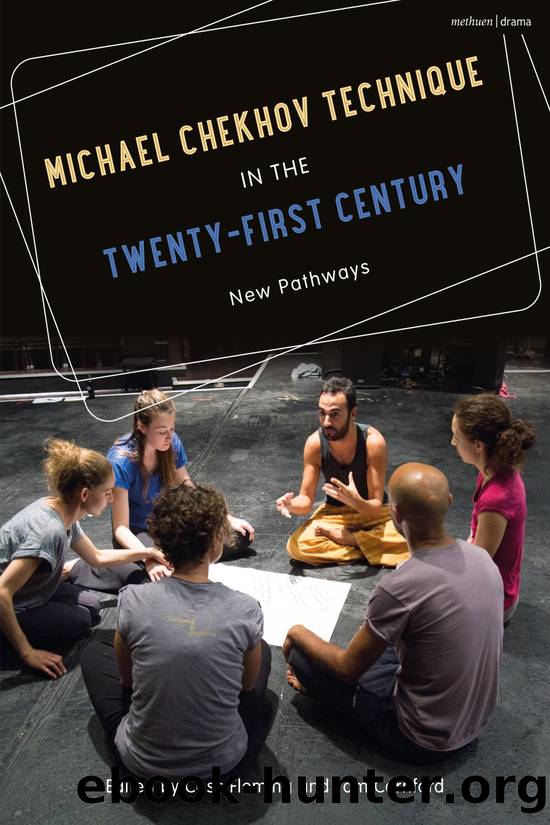Michael Chekhov Technique in the Twenty-First Century by Cass Fleming

Author:Cass Fleming
Language: eng
Format: epub
ISBN: 9781474273206
Publisher: Bloomsbury Publishing
4 âThe moment you are not inwardly moving and inwardly participating, you are deadâ
Chekhov technique in actor-movement and dance
Roanna Mitchell
This chapter is concerned with the ways in which Chekhov technique is currently used in actor-movement, dance and the crossover between them, both in terms of training and making. Discussion of Chekhovâs techniques in any context will make mention of movement, as it is woven into all aspects of his work; however, to date there is little scholarly investigation of the use of his technique in the fields of actor-movement and dance, specifically. Cass Fleming (2013) includes some discussion of these areas in her analysis of embodied play as a central aspect of Chekhovâs approach, drawing parallels with play-enabling practices in Suzanne Bingâs work and genealogies of the French tradition. Historical reviews of the pedagogic practices at Chekhovâs Theatre Studio at Dartington touch upon the role of both integrated movement work and separate movement classes, including dance classes taught by Lisa Ullmann and Eurythmy lessons, both of which will be discussed later (Chamberlain 2004; Cornford 2012; Autant-Mathieu and Meerzon 2015), and Jerri Daboo (2012) makes important links from Chekhovâs work to contemporary lineages of physical theatre practice, specifically in the UK. More recently, Lenka Pichlikova (2017) examines Chekhovâs technique in the context of teaching mask work, Commedia dellâArte and mime, while Suzanne Bennett (2013) provides the only published discussion to date on use of the technique in institutional dance training.
This chapter will refer and respond to these existing contributions and the archives of Chekhovâs work at Dartington, as well as discussing current experiments with the technique. Examples of the latter are drawn from practitioner interviews, my own practice as a movement pedagogue and performance-maker, as well as discussions at the New Pathways praxis symposium session in 2016 on Chekhov Technique in Actor-Movement and Dance. This session was attended by dancers, somatic practitioners and teacher-practitioners in the areas of actor-movement, physical theatre, embodied theatre and dance-theatre. It was led by myself and Juliet Chambers, Laban Movement Analyst and Lecturer in Actor-Movement and Dance, who gave a practical taste of the dialogue between Labanâs and Chekhovâs approach in her own teaching and contextualized this through a paper on the two practitionersâ shared interest in spirituality. This was followed by discussion of archival materials relating to the role of movement in Chekhovâs techniques, with participants focusing particularly on how the technique might help to navigate the meeting point between dance and acting as well as the relationship between inner life and the form of outer expression.
The notion of crossover, of blends and bridges, forms a key theme in this discussion, as there is no âpureâ application of Chekhovâs technique in actor-movement and dance. I therefore take a selectively genealogical approach to help us understand the web of overlaps and influences in contemporary practice. This means not only investigating Deirdre Hurst du Preyâs archive to develop a clearer picture of Chekhovâs own practice but also branching out to examine the embodied dance and mime practices
Download
This site does not store any files on its server. We only index and link to content provided by other sites. Please contact the content providers to delete copyright contents if any and email us, we'll remove relevant links or contents immediately.
1774 by Mary Beth Norton(801)
Lessons in Becoming Myself by Ellen Burstyn(701)
Blowing the Bloody Doors Off : And Other Lessons in Life (9780316451178) by Caine Michael(695)
Bette Davis: More Than a Woman by James Spada(657)
Acting in Film by Michael Caine(619)
An Actor Prepares by Constantin Stanislavski(585)
Ava Gardner: The Secret Conversations by Peter Evans & Ava Gardner(552)
Dance While You Can by Shirley Maclaine(524)
Ava Gardner by Peter Evans & Ava Gardner(521)
I Like You Just the Way I Am by Jenny Mollen(498)
Pandora's Box by Pamela Hutchinson(425)
Mickey Rourke by Sandro Monetti(423)
The Eight Characters of Comedy: A Guide to Sitcom Acting and Writing by Scott Sedita(404)
Montgomery Clift by Patricia Bosworth(402)
Speak with Distinction: The Classic Skinner Method to Speech on the Stage by Edith Skinner(392)
Gregory Peck- A Charmed Life by Lynn Haney(389)
100 (monologues) by Eric Bogosian(385)
The Viewpoints Book by Anne Bogart(359)
Things I Overheard While Talking to Myself by Alan Alda(348)
